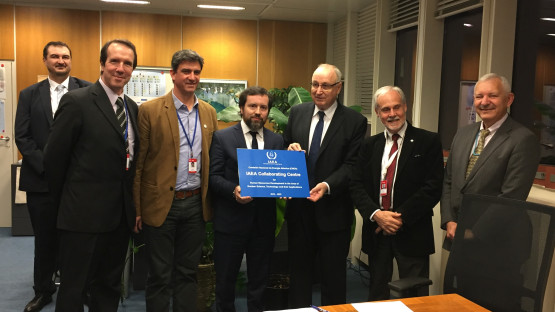With an agreement signed today in Vienna, the IAEA has designated Argentina’s National Atomic Energy Commission (CNEA) as an IAEA Collaborating Centre, enabling work on joint projects on nuclear power, fuel cycle and nuclear science techniques for development and environmental protection.
“The CNEA is already an active participant in several of the IAEA’s scientific networks and now stands set to make valuable contributions towards human resources development in the field of nuclear sciences, technologies and their applications,” said Aldo Malavasi, IAEA Deputy Director General and Head of the Department of Nuclear Science and Applications. “The purpose of the IAEA Collaborating Centres is to promote the practical use of nuclear techniques worldwide. Collaborating Centres are a great mechanism which encourages the sharing of resources, knowledge and expertise between the IAEA and its partners in many Member States.”
Under the proposed workplan, CNEA will assist the IAEA in human resources development from 2019 through 2022.
The proposed activities of the Collaborating Centre will be divided between CNEA’s three sub-centres. The Balseiro Institute, part of the Bariloche Atomic Centre, will develop an interactive graphic simulator for research reactor transients. It will provide training courses for teachers from Argentina and Latin America in nuclear energy and its applications, as well as physics, and will collaborate with and assist engineers training in malfunction prevention techniques in nuclear power plants and other nuclear facilities. The centre will also provide training in nuclear data processing and validation of different libraries as well as in analytical techniques, development and usage of associated instrumentation based on research reactors, accelerators, x-ray fluorescence and more. In addition, it will provide academic and clinical training in medical physics for postgraduate students and undertake research collaboration as part of medical physics PhD programmes. Finally, it will consult on the implementation of new radiation therapy facilities and programmes, and will conduct clinical trials and clinical and academic audits.
Activities at the Sabato Institute, part of the Constituyentes Atomic Centre, will include training in the areas of microstructure characterization of zirconium-based alloys, non-destructive testing applied to nuclear industry, nuclear power plant life management and safety culture practices, the technology of Candu pressure tubes and analytical techniques, development and usage of associated instrumentation based on research reactors, accelerators and x-ray fluorescence.
The Dan Benison Institute, part of the Ezeiza Atomic Centre, will hold training programmes in radiation and radioisotope production and their use in industrial applications, as well as in the operation and maintenance of nuclear installations for technicians and professionals, radiochemistry basics and advanced applications, such as new targets for molybdenum production and waste minimization, and research and development in nuclear instrumentation and their applications, including miniaturization for mobile in-situ measurements.
"The designation of the CNEA as an IAEA Collaborating Centre marks the positive synergy made possible by international cooperation through two important facts,” said Facundo Abel Deluchi, Director of Nuclear Policy at Argentina’s Ministry of Energy and Mining. “On one hand, the Argentine commitment, through the CNEA, with the guiding role of the IAEA's technical cooperation programme in general and its objectives at the regional level in particular. On the other hand, the IAEA's ability to multiply the contribution of national agencies for the promotion of the peaceful uses of atomic energy towards achieving the Sustainable Development Goals.”
“The Argentine experience and the historical importance given to the training of regional experts in various fields of nuclear technology will now be complemented by the coordination and leadership of IAEA programmes on nuclear energy and its fuel cycle, as well as in the applications of nuclear technology for environmental protection," he added.





